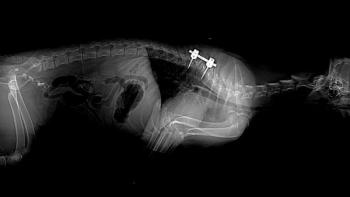
Seizures (Proceedings)
Seizure: Clinical manifestation of abnormal electrical activity in the cerebral cortex
Definitions
o Seizure: Clinical manifestation of abnormal electrical activity in the cerebral cortex
o Paroxysm: Sudden event with abrupt onset and end, used when exact nature of event is in doubt; seizures are paroxysms, but not all paroxysms are seizures
o Prodrome: Period before the seizure, potential for abnormal behavior, can last hours to days
o Aura: Initial sensation of the seizure in humans associated with start of abnormal electrical activity (may be manifested as stereotypic movements, salivation, attention seeking in animals)
o Ictus: Actual seizure event, usually seconds to minutes
o Postictal period: Transient clinical abnormalities in brain function following completion of the seizure, usually minutes to hours
o Interictal period: Time between resolution of postictal signs and onset of next seizure
o Epilepsy: Chronic condition characterized by recurrent seizures, i.e. not a single seizure; a broad category of disorders
o Provoked (Reactive) seizures: Occur at the time of systemic disorder or insult to the brain and stop when underlying condition is resolved, i.e. not epilepsy
o Idiopathic epilepsy: No identifiable brain abnormality other than seizures, implies no interictal neurologic deficits
o Symptomatic epilepsy: Seizures result from a specific cause
o Cryptogenic epilepsy: Recurrent seizures presumed to be symptomatic but currently of unknown cause
o Generalized: 1st clinical signs reflect bilateral involvement of cerebrum, consciousness generally impaired and motor signs bilateral, include tonic-clonic, tonic, clonic, atonic, myoclonic and absence
o Focal (Partial): 1st clinical signs reflect abnormal activity in one location of cerebral hemisphere, "simple" when consciousness is maintained, "complex" when consciousness is impaired, manifestations may be motor, sensory or autonomic, secondary generalization possible
o Cluster seizures: ≥ 2 seizures over brief period (minutes to within 24 hours) with normal consciousness obtained between seizures
o Status epilepticus: Seizure lasting >20-30 minutes in humans; generally used in VM for seizure lasting > 5 minutes or ≥ 2 seizures without full recovery of consciousness between seizures
Confirm seizures have occurred -history, video example, physical and neurologic exams, lectroencephalography (EEG)
Differential diagnoses
o Extracranial – seizures more likely to be generalized
• Endogenous toxins, secondary to hepatic or renal disease
• Metabolic abnormalities, e.g. hypoglycemia, electrolyte disturbances
• Endocrine disease, e.g. hypothyroidism, hyperosmolar non ketotic DM
• Toxicoses, e.g. metaldehyde, organophosphate, theobromine, caffeine, lead
o Intracranial – often characterized as progressive vs. non progressive
• Degenerative – storage diseases
• Anomalous/congenital – hydrocephalus, lissencephaly
• Metabolic – see above
• Neoplastic – primary and metastatic
• Nutritional – thiamine deficiency
• Infectious – bacterial, viral, fungal, protozoal, rickettsial, parasitic
• Inflammatory – granulomatous meningoencephalitis, necrotizing encephalitis
• Idiopathic – inherited, aquired epilepsy
• Iatrogenic – metronidazole toxicosis, overzealous correction of hyponatremia
• Traumatic – cranial trauma, cerebral hypoxia
• Toxic – see above
• Vascular – ischemic, hemorrhagic
Diagnostic evaluation – important to identify underlying etiology
o Examinations – physical, neurologic, fundic
o Extracranial evaluation
• CBC, chemistry panel, UA
• BP measurement
• Thoracic radiographs
• Abdominal US
• Thyroid panel
• Fasted BG
• Serology for infectious disease
o Intracranial evaluation
• Advanced imaging of the brain (MRI preferably, CT)
• CSF analysis
• CSF titers, PCR for infectious disease
• CT guided or surgical brain biopsy
Treat underlying disease
• -Corticosteroids – anti inflammatory vs. immunosuppressive dosing
• -Other immune modulating drugs
• -Surgery – for removal/debulking and histopathologic diagnosis
• -Antibiotics, antifungals, etc. when indicated
When to start anticonvulsant treatment – consider earlier with:
• -Structural lesion or progressive etiology
• -Status epilepticus
• -Clusters
• -1st seizure within 1 month of head trauma
• -Prolonged seizures
• -Severe or unusual postictal periods
Emergency anticonvulsants
• Benzodiazepines
o Diazepam – 0.5mg/kg IV or 1-2mg/kg per rectum, 0.5-2.0mg/kg/hr IV
o Midazolam – 0.25mg/kg IV or IM, 0.1-0.3mg/kg/hr IV
• Barbiturates
o Phenobarbital – 2-5mg/kg IV boluses, up to 20mg/kg IV in 24 hours
o Pentobarbital – 2-15mg/kg IV, works to hide physical manifestations, but not thought to be an effective anticonvulsant
• Propofol – 1-6mg/kg IV, 0.1-0.6mg/kg/min IV (with intubation)
• Levetiracetam – 20mg/kg IV or IM
Maintenance anticonvulsants
• Goal of therapy – decrease frequency and severity of seizures while avoiding serious adverse effects
• Benefits of monotherapy -
o Better owner compliance
o Potentially reduced adverse effects
o Decreased expense
• Drug selection based on:
o Type of seizures
o Age and health of patient
o Logistical/lifestyle considerations – e.g. availability for TID dosing
o Cost
• Client education
o Expected initial adverse effects
o Need for regular administration
o No changes in dosing without guidance of veterinarian
• Diazepam – occasionally used in cats, 0.5-1.0mg PO BID
o Risk of tolerance, potential hepatotoxicity
• Phenobarbital – 2-5mg/kg PO BID canine, 1-2mg/kg PO BID feline
o Sedation, polyphagia, PU/PD, occasionally hyperexcitability
o Potential for hepatotoxicity, hematologic changes require regular bloodwork
• Potassium Bromide – 35-45mg/kg PO q24h or divided
o Loading dose 400-600mg/kg over 1-5d PO
o Not recommended in cats – potential for lower respiratory disease
o Sedation, polyphagia, PU/PD
o Competes with chloride – dietary changes can affect blood levels
• Levetiracetam (Keppra) – 10-20mg/kg PO TID canine and feline
o Minimal adverse effects reported
o Increasing use with availability of generic formulation
• Zonisamide – 5-12mg/kg PO BID-TID canine, feline dosing being investigated
o Hepatic metabolism (~20%)
o Minimal adverse effects reported
• Gabapentin – 10-20mg/kg PO TID-QID
o Anecdotally not particularly effective as a sole agent
o Liquid formulation contains xylitol
• Pregabalin (Lyrica) – 2-4mg/kg PO TID
o Potential for sedation and ataxia
• Felbamate – 15-65mg/kg PO TID canine, not recommended in cats
o Potential for hepatotoxicity and blood dyscrasias
• Topiramate – 2-10mg/kg PO BID canine, 12.5-25mg PO BID-TID
o Potential for GI upset
Monitoring
o Documentation of seizures
o Therapeutic drug levels
Alternative therapies – Acupuncture? Vagal nerve stimulation? Diet change? Surgery?
Suggested reading:
Idiopathic Epilepsy in Dogs, Thomas, WB, The Veterinary Clinics of North America: Small Animal Practice, Common Neurologic Problems, 30(1), 2000
Plumb's Veterinary Drug Handbook, 6th Ed
Newsletter
From exam room tips to practice management insights, get trusted veterinary news delivered straight to your inbox—subscribe to dvm360.




